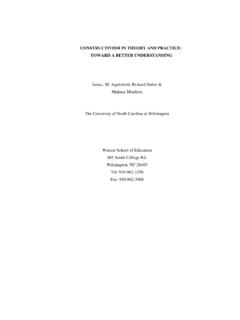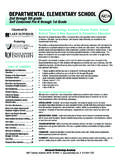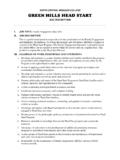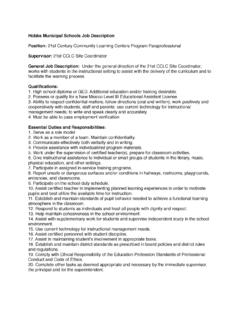Transcription of preventing chronic diseases designing and …
1 Policy brief preventing chronic diseases designing and implementing effective policy Introduction The growing epidemic of chronic disease is due to tobacco use, unhealthy diet, physical inactivity and other risk factors. Policy-makers play a crucial role in reducing the risk and burden of chronic diseases by imple- menting policies and programmes that create a healthy environment and improve access to care. A formal national policy and planning framework is essential to give chronic diseases appropriate priority and A Life Course Perspective to organize resources efficiently. Intersectoral Action chronic disease risk accumulates Complementary policies, plans and throughout the life course, and programmes developed at sub- An important step in reducing the risk factors are often established risk and burden of chronic diseases national levels play an important in childhood and adolescence.
2 Is tackling their underlying causes, Consequently, chronic disease role in responding to local needs including poverty, lack of education prevention must focus on promoting and circumstances. and unhealthy environmental healthy diet, physical activity, and conditions. These factors, as well tobacco abstinence from an early Key Methods for Achieving Goals Central Government as more proximal risk factors such age and must take into account the Leadership as unhealthy diet and physical rapid ageing of the population. inactivity, are influenced by policy Strong government leadership is decisions in many sectors of Stepwise Implementation essential for effective intersectoral government, including health, Based on Local Considerations collaboration and policy action education, transport, urban and Needs aimed at prevention and control planning, agriculture and trade. Each ministry of health must of chronic diseases .
3 Ministries of An effective, comprehensive make policy decisions according health should lead the way in this chronic disease policy depends on to its resources and its country's effort by building partnerships and coordinated action among decision- specific needs. Similarly, regional coordinating intergovernmental makers in all sectors. and local levels of government action. Comprehensive and Integrated have an important role to play in Building Partnerships Public Health Action designing tailored interventions that reflect the needs and resources Developing external partnerships A comprehensive and integrated of individual communities. There is vital for the creation of sound, approach to chronic disease policy is a full range of chronic disease comprehensive policies that is needed to minimize overlap prevention and control initiatives address the various causes and and increase cohesiveness in the that can be highly beneficial and consequences of chronic disease .
4 Health system. Policy-makers can cost-effective at both the sub- Collaboration among health strengthen public health action national and national levels. policy-makers, nongovernmental by adopting a combination of organizations, intergovernmental prevention and control strategies organizations, community leaders, that cut across specific diseases public health leaders, donors, and and address common risk factors in corporate partners is required. individuals and across populations. preventing chronic diseases : designing and implementing effective policy Policy Recommendations for Ministries of Health A comprehensive approach requires a range of interventions first, core implementation step, including the capacity for to be implemented in a stepwise manner: core, expanded and implementation, acceptability and political support. Selecting desirable. The recommendations below are not prescriptive, a small number of activities and doing them well is likely to because each ministry must consider a range of factors in have more impact than tackling a large number and doing deciding the package of interventions that constitute the them haphazardly.
5 1. CORE EXPANDED DESIRABLE. Interventions that are feasible to implement with existing resources in the short term. 2. Interventions that are possible to implement with a realistically pro- jected increase in, or reallocation 3. Evidence-based interventions that are beyond the reach of existing resources. Create an intersectoral oversight of, resources in the medium term. Enact legislation to protect the committee that meets regularly Establish a team within the minis- rights of people with chronic dis- to form policy, and later to review try of health focused specifically ease and disability. progress made in policy imple- on chronic disease prevention and Ensure that tobacco control is mentation, to identify barriers, control. being fully implemented. and develop and implement Begin implementation of compre- Ensure that the national strategy solutions. hensive tobacco control policy.
6 For diet and physical activity is Formulate and adopt an integrated, Begin implementation of the being fully implemented. national policy on chronic disease national strategy to promote prevention and management. healthy diet and physical activity. Develop a comprehensive tobacco control policy. Develop a comprehensive national strategy to promote healthy diet and physical activity. policy brief preventing chronic diseases Building a healthy school environment Introduction Skills-based Health Education chronic disease risk factors, including tobacco use, unhealthy diet and Incorporating chronic disease physical inactivity, are established at an early age. School health pro- education into classroom learning grammes that promote and facilitate healthy behaviour are one of the and extra-curricular activities is most cost-effective and efficient ways to reduce chronic disease risks an efficient way to help students in students and their families.
7 Reducing chronic disease risk helps to acquire the skills and knowledge they need to prevent and manage protect future health and allows students to take full advantage of the chronic disease . Skills-based benefits of education. The successful planning and implementation of chronic disease education should school health programmes requires a joint effort among school person- include participatory learning nel, health workers, community leaders, parents and students. experiences that address nutrition, the benefits of physical activity, and Key Components of the health consequences of tobacco use. Such programmes can be School-Based Programmes implemented with limited resources, and may be highly beneficial in School Health Policies Supportive School reducing chronic disease risk Environments factors among young people. School health policies are an essential component of chronic A supportive environment provides School Health Services disease prevention efforts.
8 Such opportunities and resources that policies guide the monitoring of make it easier for students and School health services are a risk factors, and the planning, school personnel to practice critical component of school health implementation and evaluation of healthy behaviours and adequately programmes because they allow for interventions. Health policies, such manage chronic conditions. the identification of health problems as those that ban the use of tobacco Key characteristics of such an and risk factors and for the early on school grounds, are needed environment include tobacco- detection and management of to create and maintain a healthy free buildings and grounds; the chronic diseases . They may also school environment. Collaboration availability of healthy food; safe be instrumental in providing access among school personnel, families, equipment and adequate facilities to health services for students and communities is needed to for physical activity; and support whose families are unable to afford reinforce healthy behaviours and services or referrals for counselling adequate health care.
9 Provide supportive environments or medical care related to chronic outside school. disease prevention and control. preventing chronic diseases : Building a healthy school environment Policy Recommendations for Teachers and School Administrators A comprehensive approach requires a range of interventions implementation step, including the capacity for implementation, to be implemented in a stepwise manner: core, expanded and acceptability and political support. Selecting a small number of desirable. The recommendations below are not prescriptive, activities and doing them well is likely to have more impact than because each school must consider a range of factors in decid- tackling a large number and doing them haphazardly. ing the package of interventions that constitute the first, core 1. CORE EXPANDED DESIRABLE. Interventions that are feasible to implement with existing resources in the short term.
10 2. Interventions that are possible to implement with a realistically pro- jected increase in, or reallocation 3. Evidence-based interventions that are beyond the reach of existing resources. Ban tobacco use in school build- of, resources in the medium term. Install fitness facilities and play- ings, on school grounds and at Organize school-wide sports ground equipment. school-related events. teams, clubs, activities and field Provide individual health counsel- Offer healthy foods, including trips related to healthy eating, ling and assistance programmes fruit and vegetables, in vending physical activity and tobacco to those students and personnel machines and dining areas. abstinence; as well as provide with chronic diseases and at Schedule time in each day for incentives for participation. high risk of developing chronic students and school personnel Develop a family education pro- disease .


















